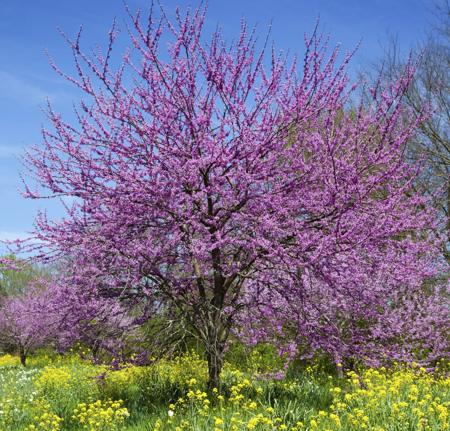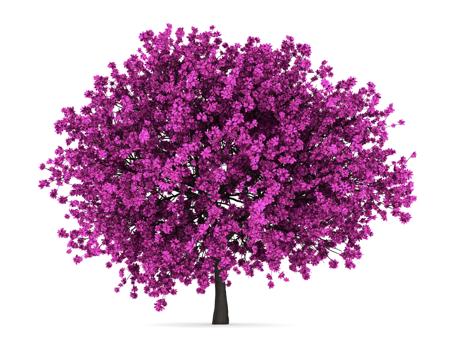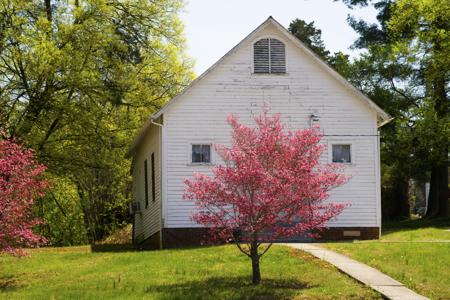





 Redbud trees are deciduous flowering plants, planted by most hobbyists for landscaping. Categorized under the pea family Leguminosae, the genus name of redbud trees is Cercis. They bloom in early spring, i.e., much before other spring-flowering trees bloom. Usually, the flowers and leaves develop at the same time. In some species, flower buds appear prior to the leaves. Either way, you get to enjoy beautiful redbud trees laden with fragrant blossoms in the yard.In summer, after the flowering season is over, you can still enjoy a spectacular view of the trees adorned attractive leaves. The young leaves are deep maroon in color, while mature leaves are lustrous, smooth, and dark green. So, it won't be wrong to say, redbud trees are ornamental plants for all seasons. Discussed below are some redbud tree facts, including their identification, varieties, hardiness, and pathogen infestations.Redbud Tree Size and Growth RateMost of the redbud trees are small tree versions, which hardly reach 30 feet. Some dwarf species grow to a maximum height of 12 feet, and they are suited for container gardening. In mature redbud trees, the height is same as the tree spread. Hence, they resemble a spectacular round form, when maintained correctly. The recorded redbud tree growth rate is recorded to be 12 - 18 inch per year. As far as the longevity is concerned, this deciduous tree continues to grow for 35 - 40 years.
Redbud trees are deciduous flowering plants, planted by most hobbyists for landscaping. Categorized under the pea family Leguminosae, the genus name of redbud trees is Cercis. They bloom in early spring, i.e., much before other spring-flowering trees bloom. Usually, the flowers and leaves develop at the same time. In some species, flower buds appear prior to the leaves. Either way, you get to enjoy beautiful redbud trees laden with fragrant blossoms in the yard.In summer, after the flowering season is over, you can still enjoy a spectacular view of the trees adorned attractive leaves. The young leaves are deep maroon in color, while mature leaves are lustrous, smooth, and dark green. So, it won't be wrong to say, redbud trees are ornamental plants for all seasons. Discussed below are some redbud tree facts, including their identification, varieties, hardiness, and pathogen infestations.Redbud Tree Size and Growth RateMost of the redbud trees are small tree versions, which hardly reach 30 feet. Some dwarf species grow to a maximum height of 12 feet, and they are suited for container gardening. In mature redbud trees, the height is same as the tree spread. Hence, they resemble a spectacular round form, when maintained correctly. The recorded redbud tree growth rate is recorded to be 12 - 18 inch per year. As far as the longevity is concerned, this deciduous tree continues to grow for 35 - 40 years. Redbud Tree IdentificationIdentifying a tree is easy, since each of the species bears some distinctive features. The leaf is a unique round, heart-shaped, which color differs from one cultivar to another. Also, depending upon the variety, the flower shades may be white, pale pink, or rosy pink. Flower buds are developed directly from the branch, and the twigs are laden with blooms in the peak flowering season. As winter arrives, pods measuring about 3 inch will develop from the flowers.
Redbud Tree IdentificationIdentifying a tree is easy, since each of the species bears some distinctive features. The leaf is a unique round, heart-shaped, which color differs from one cultivar to another. Also, depending upon the variety, the flower shades may be white, pale pink, or rosy pink. Flower buds are developed directly from the branch, and the twigs are laden with blooms in the peak flowering season. As winter arrives, pods measuring about 3 inch will develop from the flowers. Redbud Tree VarietiesThe two most popular cultivars of redbud trees are eastern redbud tree (Cercis canadensis), also known as American redbud tree and western redbud tree (Cercis occidentalis). Others are alba (white flowers), forest pansy (purplish foliage and rosy-purple blooms), silver cloud (variegated foliage), and flame (double pink blooms). A sought after variety remarkable for its weeping branches is the covey redbud.Redbud Tree Ornamental ValueThe small rounded canopy shape of redbud trees make them ideal for planting in any type of landscape design. They are planted as specimens in the landscape or as shade trees. Planting them in a row gives a spectacular view during the flowering season. Besides ornamental value, the flowers of redbud trees are fragrant and edible. They are eaten raw in salads or prepared by boiling and frying. Young redbud fruits and seeds are a favorite food for birds, deer, and cardinals.
Redbud Tree VarietiesThe two most popular cultivars of redbud trees are eastern redbud tree (Cercis canadensis), also known as American redbud tree and western redbud tree (Cercis occidentalis). Others are alba (white flowers), forest pansy (purplish foliage and rosy-purple blooms), silver cloud (variegated foliage), and flame (double pink blooms). A sought after variety remarkable for its weeping branches is the covey redbud.Redbud Tree Ornamental ValueThe small rounded canopy shape of redbud trees make them ideal for planting in any type of landscape design. They are planted as specimens in the landscape or as shade trees. Planting them in a row gives a spectacular view during the flowering season. Besides ornamental value, the flowers of redbud trees are fragrant and edible. They are eaten raw in salads or prepared by boiling and frying. Young redbud fruits and seeds are a favorite food for birds, deer, and cardinals. Redbud Tree HardinessRedbud trees are best grown in USDA hardiness zones 4 - 9. They tolerate partial shade, but bear maximum blooms when grown in full sunlight. Redbud trees are also very hardy in terms of soil requirements; you can plant them in any type of soil, provided that it is not wet and swampy. In addition, the redbud plant can be propagated from seeds and it grows well in containers too. The only concern with this ornamental tree is fungal disease that often causes destructive damage.Redbud Tree Planting and CareMajority of the redbud tree varieties are easy to grow and care for. You can maintain healthy trees with the basic care tips that include timely watering, fertilization, pruning, and taking up disease control methods. Similar to other landscaping trees, redbud tree pruning should be done in the dormant period, preferably in fall. Of course, you can trim them in late spring, immediately after the flowers drop. Remove crowded branches to allow sunlight penetration and reduce disease attacks.Redbud Tree Diseases and PestsDestructive diseases are mostly caused by fungal infections, of which some include verticillium wilt, canker or dieback, and leaf spots. To save your infected trees, early identification is necessary. Consider discarding the diseased parts properly and spraying them with appropriate fungicides. Insects affecting redbud trees are spider mites, scale insects, and tree hoppers. In case of pest attacks, simply remove them at the first sight and follow cultural practices to control them.Remember that disease and pest infestations are frequent when the trees are in stress or exposed to unfavorable growing conditions. In such cases, your redbud trees will be in a weakened state, and they are easily attacked by disease-causing pathogens. So, be sure to provide optimal growth conditions and enjoy bountiful beauty of redbud trees.
Redbud Tree HardinessRedbud trees are best grown in USDA hardiness zones 4 - 9. They tolerate partial shade, but bear maximum blooms when grown in full sunlight. Redbud trees are also very hardy in terms of soil requirements; you can plant them in any type of soil, provided that it is not wet and swampy. In addition, the redbud plant can be propagated from seeds and it grows well in containers too. The only concern with this ornamental tree is fungal disease that often causes destructive damage.Redbud Tree Planting and CareMajority of the redbud tree varieties are easy to grow and care for. You can maintain healthy trees with the basic care tips that include timely watering, fertilization, pruning, and taking up disease control methods. Similar to other landscaping trees, redbud tree pruning should be done in the dormant period, preferably in fall. Of course, you can trim them in late spring, immediately after the flowers drop. Remove crowded branches to allow sunlight penetration and reduce disease attacks.Redbud Tree Diseases and PestsDestructive diseases are mostly caused by fungal infections, of which some include verticillium wilt, canker or dieback, and leaf spots. To save your infected trees, early identification is necessary. Consider discarding the diseased parts properly and spraying them with appropriate fungicides. Insects affecting redbud trees are spider mites, scale insects, and tree hoppers. In case of pest attacks, simply remove them at the first sight and follow cultural practices to control them.Remember that disease and pest infestations are frequent when the trees are in stress or exposed to unfavorable growing conditions. In such cases, your redbud trees will be in a weakened state, and they are easily attacked by disease-causing pathogens. So, be sure to provide optimal growth conditions and enjoy bountiful beauty of redbud trees.
Copyright © www.100flowers.win Botanic Garden All Rights Reserved